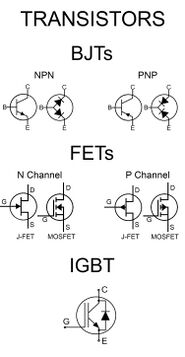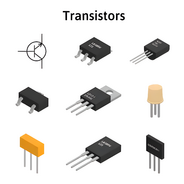More actions
| Transistors - Repair Basics | |
|---|---|
| Type | Component |
| Device(s) | Transistors |
| Difficulty | ◉◉◌◌ Medium |
This article is a stub. You can help Repair Wiki grow by expanding it
This article aims to provide a comprehensive overview of transistors from a repair perspective, detailing their function, types, common issues, testing methods, and replacement considerations.

What is a Transistor?
A transistor is a crucial semiconductor device in electronics that amplifies or switches electronic signals. Transistors come in various types, and each type serves a specific purpose in electronic circuits.
Transistors come in different types: Bipolar Junction Transistors (BJTs), Field-Effect Transistors (FETs), and Isolated Gate Bipolar Transistors (IGBTs)
Transistors are typically identified by the symbols shown in Figure 1 and are usually denoted with the letter Q followed by an identifier number. (E.g., Q27)
Function
Transistors serve various functions in electronic circuits, including:
Amplification
Transistors amplify weak electronic signals to higher levels. This is essential in audio amplifiers, signal processing, and more.
Switching
Transistors can be used as electronic switches to control the flow of current in a circuit. They are used in digital logic circuits, microcontrollers, and more.
Voltage Regulation
In power supplies, transistors are used for voltage regulation by rapidly switching on and off to either boost or step down the voltage depending on the circuit.
Motor Control
Transistors, especially power IGBTs, are used in motor control circuits to drive and control the speed of 3 phase electric motors in appliances, robotics, and industrial equipment.

Types
Bipolar Junction Transistors (BJTs)
BJTs come in two types:
NPN
An NPN transistor has three layers: the collector, base, and emitter. It allows current to flow from the collector to the emitter when a small current is applied to the base. NPN transistors are commonly used in amplification circuits.
PNP
A PNP transistor operates similarly to an NPN transistor, but the direction of current flow is reversed. Current flows from the emitter to the collector when a small current is pulled from the base. PNP transistors are also used for amplification and switching though much less commonly.
Field-Effect Transistors (FETs)
FETs are classified into JFETs (Junction Field-Effect Transistors) and MOSFETs (Metal-Oxide-Semiconductor Field-Effect Transistors), they both work in a similar way and both come in two types:
N-Channel
N-Channel FETs acts as an electronic switch between the drain and source when the gate is positively charged in relation to the source. The gate-to-source effectively forms a small capacitor, and the magnitude of current between the drain and source is directly linked to the charge on the gate. Consequently, unless the gate is actively discharged, the N-Channel FETs will remain in a conducting state. No current flows from the gate to source.
P-Channel
Works in opposite way to N-Channel, P-Channel FETs also act as an electronic switch between the drain and source but when the gate is negatively charged in relation to the source. The gate-to-source effectively forms a small capacitor, and the magnitude of current between the drain and source is directly linked to the negative charge on the gate. Consequently, unless the gate is actively being charged, the N-Channel FETs will remain in a conducting state. No current flows from the source to gate.
Insulated Gate Bipolar Transistors (IGBTs)
IGBTs combine the characteristics of BJTs and MOSFETs. They are used in high-voltage, high-current switching applications like inverter drives and power inverters. Current flows from the collector to the emitter if the gate is positively charged in relation to the emitter. Same case with the FET, if the gate is not being discharged, the IGBT will stay conducting until the gate is discharged.
Testing a Transistor
Make sure the transistor does not have any physical damage such as burn marks or corrosion first! That's the quickest way of identifying a faulty transistor.
Usually, transistors fail in a short circuit where all the pins are shorted together. In such instances, it becomes crucial to thoroughly inspect and measure the entire circuit, as this short circuit indicates an excessive current flow through the gate or base which could easily damage other components connected to the transistor.
BJTs
Testing a BJT is essentially testing two diodes like is shown on Figure 1.
- Identify the transistor's pins and determine which is the base, emitter and collector.
- Firstly, make sure the FET is not shorted, measure the resistance between the collector (C) and the emitter (E). If you measure below 100 Ohms that means the BJT is shorted.
- if the BJT is not shorted, set your multimeter to diode mode.
- Connect the red probe to the base (B) and the black probe to the collector (C). If the transistor is NPN, the multimeter should read a diode drop (typically 0.6 - 0.7 V).
- Now move the negative probe to the emitter (E) you should measure the same or similar diode voltage drop, indicating the transistor is functioning properly.
- For PNP, repeat the same but reverse the meter probes (black on base), you should read the same diode values.
- If you measure a voltage drop that is substantially higher or lower or "OL" this means the transistor is faulty.
FETs
You can verify the functionality of the FETs by charging or discharging the gate (G), which causes the drain (D) and source (S) to become conducting. This can be tested using a multimeter on diode mode.
- Identify the transistor's pins and determine which is the gate, drain and source.
- Firstly, make sure the FET is not shorted, measure the resistance between the drain (D) and the source (S). If you measure below 100 Ohms that means the FET is shorted.
- If the FET is not shorted, set your multimeter to diode mode.
- For N-Channel FETs, connect the red probe to the gate (G) and the black probe to the source (S).
- Quickly switch the red probe to drain (D), you should measure a very very low voltage drop (close to 0) confirming the operation of the FET.
- For P-Channel FETs, repeat the same but reverse the meter probes (black on gate), you should read the same diode values.
- If you read a high voltage drop or "OL" that means the FET is faulty.
Alternatively, you can measure the capacitance of the gate (G) against the source (S) if you have access to and LCR meter. Value should be compared to the datasheet or a similar FET.
IGBTs
- Identify the transistor's pins and determine which is the gate, emitter and collector.
- Set your multimeter to diode mode.
- Usually, IGBTs come with a diode connected in reverse parallel "freewheeling diode" (figure 1) to allow current to pass in the other direction. This means that all you have to do to measure an IGBT is check if the diode is still functional.
- Place the red probe on the emitter (E) and black probe on collector (C), you should measure a diode voltage drop (typically 0.4 - 0.7 V).
- If you read a high or low voltage drop, or "OL" that means the IGBT is faulty.
If you have access to a LCR meter, measure the gate (G) capacitance against the emitter (E). Value should be compared to the datasheet or a similar IGBT.
Replacement Considerations
If you can't replace the transistor with the exact same one, it is possible to use a different one while considering the following factors for each type. Regardless, MAKE SURE THE PIN OUT MATCHES! If not, you most likely will kill everything connected to it!.
BJTs
- BJT type: Ensure you select the correct type (NPN or PNP) based on the original transistor's function.
- Package Type: Choose a replacement transistor with a compatible package type and pinout.
- Voltage and Current Ratings: "VCE" and "IC". Match or exceed the voltage and current ratings of the replacement transistor to the original to avoid overloading the transistor.
- Gain: In amplification applications, closely match the gain (hFE) of the replacement transistor to the original for proper amplification.
- Power Dissipation: Ensure the replacement transistor can handle the same or higher power dissipation as the original.
FETs
- FET type: Ensure you select the correct type (N or P channel) based on the original transistor's function.
- Package Type: Choose a replacement transistor with a compatible package type and pinout.
- Voltage and Current Ratings: "VDS" and "ID". Match or exceed the voltage and current ratings of the replacement transistor to the original to avoid overloading the transistor.
- RDSon: Resistance when turned on, It is very important to pick a FET that has the same or lower on resistance.
- Gate Capacitance: Try to stick to a FET with a close gate charge to the faulty one.
- Switching Characteristics: Pay attention to "Turn On/Off Delay Time" and "Rise/Fall Time" especially for sensitive switching applications.
- Power Dissipation: Ensure the replacement transistor can handle the same or higher power dissipation as the original.
IGBT
- Package Type: Choose a replacement transistor with a compatible package type and pinout.
- Voltage and Current Ratings: "VDS" and "ID". Match or exceed the voltage and current ratings of the replacement transistor to the original to avoid overloading the transistor.
- RDSon: Resistance when turned on, It is very important to pick a FET that has the same or lower on resistance.
- Gate Capacitance: Try to stick to a FET with a close gate charge to the faulty one.
- Switching Characteristics: Pay attention to "Turn On/Off Delay Time" and "Rise/Fall Time" especially for sensitive switching applications.
- Power Dissipation: Ensure the replacement transistor can handle the same or higher power dissipation as the original.
Replacing a transistor with the wrong specifications can lead to circuit damage! It's essential to choose a replacement carefully.
